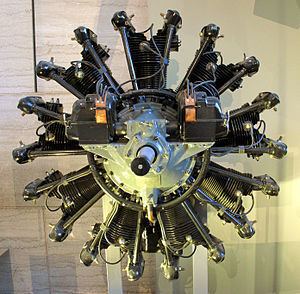First run 1923 | ||
 | ||
Major applications Spirit of St. Louis; Fokker Trimotor; Ford Trimotor | ||
The Wright R-790 Whirlwind was a series of nine-cylinder air-cooled radial aircraft engines built by Wright Aeronautical Corporation, with a total displacement of about 790 cubic inches (12.9 L) and around 200 horsepower (150 kW). These engines were the earliest members of the Wright Whirlwind engine family.
Contents
Design and development
The R-790 Whirlwind began as the Lawrance J-1, a nine-cylinder air-cooled radial developed in 1921 by the Lawrance Aero Engine Company for the U.S. Navy. The Navy was very enthusiastic about air-cooled engines, which it felt were better suited for naval use than liquid-cooled ones. Lawrance was a small company, though, and the Navy doubted it could produce enough engines for their needs. Despite urgings from the Navy, the major U.S. aircraft engine makers, Wright and Curtiss, were satisfied with their liquid-cooled engines and showed no interest in building air-cooled ones. Since the Navy was already a major purchaser of Wright engines, it decided to force the issue by suggesting that Wright purchase Lawrance and build the J-1 itself, while informing the company that the Navy would not buy any more of its existing engines or spare parts. To keep the Navy's business, Wright was thus compelled to buy Lawrance in 1923, and the Lawrance J-1 became the Wright J-1.
By the time Lawrance merged with Wright, it had already developed the J-2, a more powerful version of the J-1 with slightly enlarged bore and displacement. However, Lawrance decided the J-1 was large enough, and the J-2 never went into production; only two examples were built.
Over the next two years, Wright gradually refined the J-1 engine, introducing the J-3, J-4, J-4A, and J-4B. The changes improved the engine's reliability, cooling, and fuel consumption, but the basic design, dimensions, and performance were unaltered.
The J-4 was the first engine to bear the Whirlwind name; previous engines had no name, only a designation.
The J-5 Whirlwind, introduced in 1925, was a complete redesign of the engine which greatly improved its cooling and breathing, further increasing its reliability and reducing its fuel consumption. Among the more visible changes were a much wider separation between the valves, for better cooling airflow, and completely enclosed pushrods and rocker arms, rather than exposed ones as on the earlier engines.
The U.S. government later designated the J-5 Whirlwind as the R-790, but it did not apply this designation to the older engines.
All these engines had a bore of 4.5 in (11.4 cm), a stroke of 5.5 in (14.0 cm), and a displacement of 788 in3 (12.91 L).
In a 1928 report on transcontinental aviation, the author noted that a typical five-seat commercial aircraft cost $12,500 of which $5,000 was for one of the 350 200 hp Whirlwind Engines available that year. The J-5 was the last of the original nine-cylinder Whirlwinds. In 1928, it was replaced by the seven-cylinder version of the Whirlwind J-6.
Operational history
Many Whirlwind engines were used in U.S. Navy aircraft, mostly in trainers, but also in some ship-based observation and fighter aircraft. As the engines were refined and their reputation for reliability grew, their use expanded to U.S. Army trainers and a wide range of U.S. civil aircraft, including the earliest versions of the Fokker Trimotor and Ford Trimotor airliners.
The reliability of J-5 Whirlwind engines also led aviators to use them for a number of record-setting distance and endurance flights. The most famous of these is Charles Lindbergh's solo transatlantic flight from New York City to Paris on May 20–21, 1927, in the Spirit of St. Louis, powered by a single Whirlwind J-5C. During Lindbergh's flight, the engine ran continuously for 33.5 hours. Lindbergh's achievement greatly boosted the Whirlwind's already good reputation.
Some other historic long-duration flights made in aircraft powered by the J-5 Whirlwind:
Charles L. Lawrance, who developed the original Whirlwind series and became president of Wright, won the 1927 Collier Trophy for his work on air-cooled radial aircraft engines.
Licence-built versions
The J-5 Whirlwind was built by Hispano-Suiza in France.
The Whirlwind J-5 was also produced under license in Poland by several makers. Among these were Polskie Zakłady Skody, the Polish branch of Škoda Works, which built about 350 to 400 engines from 1929 to 1931, and the Polish firm Avia, which manufactured a further 300 engines from 1935 to 1938. Polish-built J-5s were used in numerous Polish aircraft, mostly in military training, observation, and liaison aircraft.
Variants
Polish aircraft, using Polish-built engines
Aircraft from other countries
Engines on display
Some museums which have J-5 Whirlwinds (or the military R-790 equivalents) on display:
Also in display at the San Francisco International Airport, International Terminal. Older Whirlwinds on display are harder to find. The National Museum of Naval Aviation has two J-4s, one of which is a cutaway. The New England Air Museum in Windsor Locks, Connecticut, has a Lawrance J-1, the Whirlwind's direct predecessor.
Specifications (R-790 Whirlwind J-5)
Data from Type certificate data sheet for the Whirlwind J-5; dimensions from "Model Designations of U.S.A.F. Aircraft Engines"
